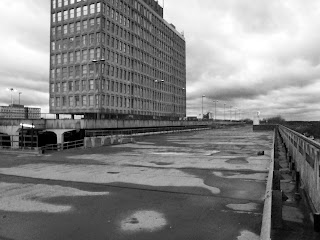Cedric Delsaux is a French photographer born in 1974. He originally studied literature and cinema before turning to photography. Possibly his most popular series is 'Dark Lens', which features characters from Star Wars placed in real images blurs the line between fantasy and reality creating a post-apocalyptic feeling to his work. Although the images appear so realistic, we know that they are manipulated images as we know that the characters are fictional. 1784 is another series that Delsaux created which he describes as 'like a maze with no beginning and no end, at the same time totally real and absolutely false, a theatre stage, film set, haunting music, a wonder, 1784 is a random tale, just like a reflection of our lives.' In this series he collides past and present rather than fictional and reality. Below are some images from his 'Dark Lens' series.
I like this image due to the high contrast in colour between the characters and the background. Both the sky and the roof are dull, de-saturated grey tones which make the image seem dreary and unappealing, but with the addition of the characters it makes the image pop due to the brightness of their clothing. The red colour could connote danger or blood.
I like this image as it is a true representation of how Cedric Delsaux pulls together fantasy and reality. On the far side of the image we can see a city full of skyscraper buildings with bright lights. Towards the front, however, we see a droid army in a desert-like location which is almost the complete opposite. Although the two locations are so different, it seems to fit in the image.
This image is a more subtle example of his Star Wars/reality work. Instead of featuring characters from the film, it features a prop - the lightsaber. Whilst it is not as obvious as the other pictures, it still works really well as part of his image due to the fact that the landscape is quite dark and the lightsaber is so bright. The way that the grass around it has turned red makes it look completely natural.




































